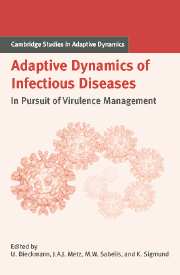Book contents
- Frontmatter
- Contents
- Contributing Authors
- List of Boxes
- Notational Standards
- 1 Introduction
- A Setting the Stage
- Introduction to Part A
- 2 Alternative Transmission Modes and the Evolution of Virulence
- 3 Wildlife Perspectives on the Evolution of Virulence
- 4 Adaptive Dynamics of Pathogen–Host Interactions
- 5 Dilemmas in Virulence Management
- B Host Population Structure
- C Within-Host Interactions
- D Pathogen–Host Coevolution
- E Multilevel Selection
- F Vaccines and Drugs
- G Perspectives for Virulence Management
- References
- Index
- International Institute for Applied Systems Analysis
2 - Alternative Transmission Modes and the Evolution of Virulence
Published online by Cambridge University Press: 15 January 2010
- Frontmatter
- Contents
- Contributing Authors
- List of Boxes
- Notational Standards
- 1 Introduction
- A Setting the Stage
- Introduction to Part A
- 2 Alternative Transmission Modes and the Evolution of Virulence
- 3 Wildlife Perspectives on the Evolution of Virulence
- 4 Adaptive Dynamics of Pathogen–Host Interactions
- 5 Dilemmas in Virulence Management
- B Host Population Structure
- C Within-Host Interactions
- D Pathogen–Host Coevolution
- E Multilevel Selection
- F Vaccines and Drugs
- G Perspectives for Virulence Management
- References
- Index
- International Institute for Applied Systems Analysis
Summary
Introduction: Historical Background
For most of the 20th century, medical scientists writing about the evolution of infectious diseases generally concluded that parasites are expected to evolve toward states of benign coexistence with their hosts (reviewed in Ewald 1994a). According to this line of reasoning, parasites that harm their hosts are harming their own long-term chances of survival, and are therefore at a disadvantage over evolutionary time. Theory developed since the 1980s emphasizes that this traditional viewpoint is based on faulty assumptions about the level at which natural selection acts. Specifically, natural selection is a process by which organismal variants that contribute more of their genetic instructions into future generations become increasingly represented in the gene pool of future generations. When applied to parasite virulence, the appropriate focus is therefore on the short-term competitive processes among parasite variants rather than on the characteristics that would allow a particular parasite species to persist most stably over the long term. According to this reasoning, by the time any variants reap such long-term benefits, they would already have been displaced by the variants that held the short-term advantage. Any increases in long-term survival of the parasite species associated with benignity are therefore of little if any relevance to the evolution of virulence if benign strains lose the short-term competition.
- Type
- Chapter
- Information
- Adaptive Dynamics of Infectious DiseasesIn Pursuit of Virulence Management, pp. 10 - 25Publisher: Cambridge University PressPrint publication year: 2002
- 10
- Cited by



